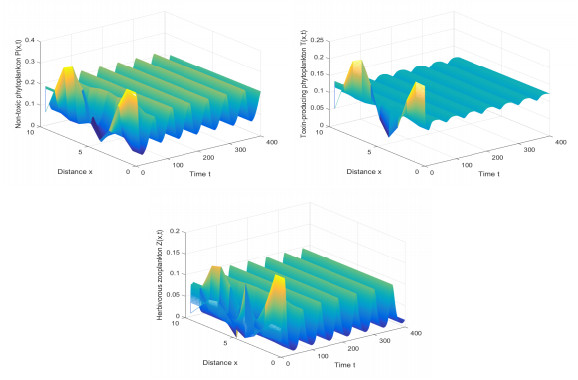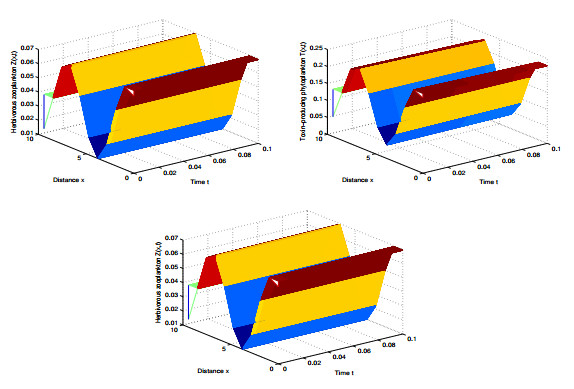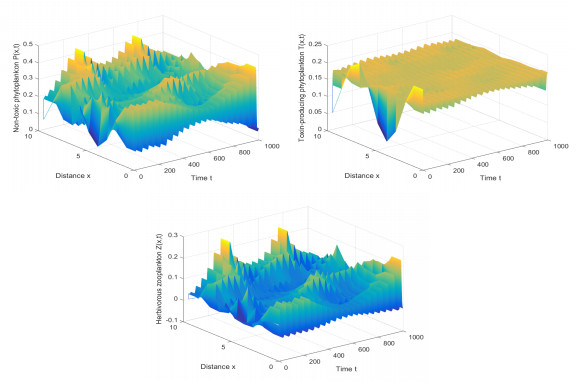|
[1]
|
K. Agnihotri and H. Kaur, The dynamics of viral infection in toxin producing phytoplankton and zooplankton system with time delay, Chaos, Solitons and Fractals, 2019, 118, 122-133. doi: 10.1016/j.chaos.2018.11.018
CrossRef Google Scholar
|
|
[2]
|
M. Banerjee and E. Venturino, A phytoplankton-toxic phytoplankton-zooplankton model, Ecological Complexity, 2011, 8, 239-248. doi: 10.1016/j.ecocom.2011.04.001
CrossRef Google Scholar
|
|
[3]
|
J. Chattopadhayay, R. R. Sarkar and S. Mandal, Toxin-producing plankton may act as a biological control for planktonic blooms--field study and mathematical modelling, Journal of Theoretical Biology, 2002, 215, 333-344. doi: 10.1006/jtbi.2001.2510
CrossRef Google Scholar
|
|
[4]
|
J. Chattopadhyay, R. R. Sarkar and S. Pal, Mathematical modelling of harmful algal blooms supported by experimental findings, Ecological Complexity, 2004, 1, 225-235. doi: 10.1016/j.ecocom.2004.04.001
CrossRef Google Scholar
|
|
[5]
|
J. P. Connolly and R. B. Coffin, Model of carbon cycling in planktonic food webs, Journal of Environmental Engineering, 1995, 121, 682-690. doi: 10.1061/(ASCE)0733-9372(1995)121:10(682)
CrossRef Google Scholar
|
|
[6]
|
M. G. Crandall and P. H. Rabinowitz, Bifurcation from simple eigenvalues, Journal of Functional Analysis, 1971, 8, 321-340. doi: 10.1016/0022-1236(71)90015-2
CrossRef Google Scholar
|
|
[7]
|
M. G. Crandall and P. H. Rabinowitz, Bifurcation, perturbation of simple eigenvalues, and linearized stability, Archive for Rational Mechanics and Analysis, 1973, 52, 161-180. doi: 10.1007/BF00282325
CrossRef Google Scholar
|
|
[8]
|
S. Djilali, Effect of herd shape in a diffusive predator-prey model with time delay, Journal of Applied Analysis and Computation, 2019, 9, 638-654.
Google Scholar
|
|
[9]
|
J. H. Edwards, The role of predation in plankton models, Journal of Plankton Research, 1992, 14, 157-172. doi: 10.1093/plankt/14.1.157
CrossRef Google Scholar
|
|
[10]
|
G. M. Hallegraeff, A review of harmful algae blooms and their apparent global increase, Phycologia, 1993, 32, 79-99. doi: 10.2216/i0031-8884-32-2-79.1
CrossRef Google Scholar
|
|
[11]
|
R. Han and B. Dai, Spatiotemporal pattern formation and selection induced by nonlinear cross-diffusion in a toxic-phytoplankton-zooplankton model with Allee effect, Nonlinear Analysis: Real World Applications, 2019, 45, 82-853.
Google Scholar
|
|
[12]
|
G. C. Hays, A. J. Richardson and C. Robinson, Climate change and marine plankton, Trends in Ecology and Evolution, 2005, 20, 337-344. doi: 10.1016/j.tree.2005.03.004
CrossRef Google Scholar
|
|
[13]
|
S. Jang, J. Baglama and L. Wu, Dynamics of phytoplanktonšCzooplankton systems with toxin producing phytoplankton, Applied Mathematics and Computation, 2014, 227, 717-740. doi: 10.1016/j.amc.2013.11.051
CrossRef Google Scholar
|
|
[14]
|
T. Kato, Functional Analysis, Springer-Verlag, Berlin, 1995.
Google Scholar
|
|
[15]
|
C. Li, X. Wang and Y. Shao, steady states of a predator-prey model with prey-taxis, Nonlinear Analysis, 2014, 97, 155-168. doi: 10.1016/j.na.2013.11.022
CrossRef Google Scholar
|
|
[16]
|
Z. Mei, Numerical Bifurcation Analysis for Reaction-Diffusion Equations, Springer-Verlag, Berlin, 2003.
Google Scholar
|
|
[17]
|
A. Mondal, A. K. Pal and G. P. Samanta, Rich dynamics of non-toxic phytoplankton, toxic phytoplankton and zooplankton system with multiple gestation delays, International Journal of Dynamics and Control, 2018. DOI: https://doi.org/10.1007/s40435-018-0501-4.
Google Scholar
|
|
[18]
|
K. J. Richards, Viral infections of oceanic plankton blooms, Journal of Theoretical Biology, 2017, 412, 27-35. doi: 10.1016/j.jtbi.2016.09.022
CrossRef Google Scholar
|
|
[19]
|
T. Saha and M. Bandyopadhyay, Dynamical analysis of toxin producing PhytoplanktonšCZooplankton interactions, Nonlinear Analysis: Real World Applications, 2009, 10, 314-332. doi: 10.1016/j.nonrwa.2007.09.001
CrossRef Google Scholar
|
|
[20]
|
A. K. Sharma, A. Sharma and K. Agnihotri, Spatiotemporal Dynamic of Toxin Producing Phytoplankton (TPP)-Zooplankton Interaction, International Journal of Mathematical Modelling and Computations, 2016, 6, 189-197.
Google Scholar
|
|
[21]
|
Y. Song and X. Tang, Stability, steady-state bifurcations, and Turing patterns in a predator-prey model with herd behavior and prey-taxis, Studies in Applied Mathematics, 2017, 139, 371-404. doi: 10.1111/sapm.12165
CrossRef Google Scholar
|
|
[22]
|
A. M. Steele and A. Yool, The role of higher predation in plankton population models, Journal of Plankton Research, 2000, 22, 1085-1112. doi: 10.1093/plankt/22.6.1085
CrossRef Google Scholar
|
|
[23]
|
N. K. Thakur, S. K. Tiwari and R. K. Upadhyay, Harmful algal blooms in fresh and marine water systems: The role of toxin producing phytoplankton, International Journal of Biomathematics, 2016, 1650043, 20.
Google Scholar
|
|
[24]
|
H. V. Thurman and A. P. Trujillo, Introductory oceanography, Prentice Hall, Englewood, 1997.
Google Scholar
|
|
[25]
|
R. K. Upadhyay, N. Kumari and V. Rai, Exploring dynamical complexity in diffusion driven predator-prey systems: Effect of toxin producing phytoplankton and spatial heterogeneities, Chaos, Solitons and Fractals, 2009, 42, 584-594. doi: 10.1016/j.chaos.2009.01.027
CrossRef Google Scholar
|
|
[26]
|
Q. Wang, Y. Song and L. Shao, Nonconstant positive steady states and pattern formation of 1D prey-taxis systems, Journal of Nonlinear Science, 2017, 27, 71-97. doi: 10.1007/s00332-016-9326-5
CrossRef Google Scholar
|
|
[27]
|
W. Wang, S. Liu, D. Tian and D. Wang, Pattern dynamics in a toxin-producing phytoplankton-zooplankton model with additional food, Nonlinear Dynamics, 2018, 94, 211-228. doi: 10.1007/s11071-018-4354-3
CrossRef Google Scholar
|
|
[28]
|
Y. Wang, H. Wang and W. Jiang, Hopf-transcritical bifurcation in toxic phytoplankton-zooplankton model with delay, Journal of Mathematical Analysis and Applications, 2014, 415, 574-594. doi: 10.1016/j.jmaa.2014.01.081
CrossRef Google Scholar
|
|
[29]
|
M. Yousefnezhad and S. A. Mohammadi, Stability of a predator-prey system with prey taxis in a general class of functional responses, 2016, 36, 62-72.
Google Scholar
|
|
[30]
|
J. Zhang, S. Wang and X. Kong, Effects of toxin delay on the dynamics of a phytoplankton-zooplankton model, Physica A, 2018, 505, 1150-1162. doi: 10.1016/j.physa.2018.04.049
CrossRef Google Scholar
|
|
[31]
|
L. Zhang and S. Fu, Global bifurcation for a Holling-Tanner predator-prey model with prey-taxis, Nonlinear Analysis: Real World Applications, 2019, 47, 460-472. doi: 10.1016/j.nonrwa.2018.12.002
CrossRef Google Scholar
|
|
[32]
|
T. Zhang, X. Liu, X. Meng and T. Zhang, Spatio-temporal dynamics near the steady state of a planktonic system, Computers and Mathematics with Applications, 2018, 75, 4490-4504. doi: 10.1016/j.camwa.2018.03.044
CrossRef Google Scholar
|
|
[33]
|
J. Zhao, J. Tian and J. Wei, Minimal model of plankton systems revisited with spatial diffusion and maturation delay, Bulletin of Mathematical Biology, 2016, 78, 381-412. doi: 10.1007/s11538-016-0147-3
CrossRef Google Scholar
|






 DownLoad:
DownLoad:



